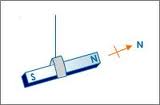Now that we have seen various structural aspects of building a brand ; what remains to be encroached upon is the topic of – “How to sustain it , once you have built it?”[/b]
[/b]
Sustenance and follow-up is very crucial for any process. If you leave your Knife out in the open after sharpening it on the grindstone; what will happen ? Of-course it will rust , degrade and eventually will be of no use ; even to cut a birthday cake.[/b]
[/b]
So how to do it ?[/b]
[/b]Have you seen a Bar magnet , suspended freely by a string ? What does it do ?[/b]

It points in the North-South direction. In the same way you need to bring in direction to your brand , continuously ; even when it has its foot glued to the market. But unlike a Bar Magnet , people and ventures don’t align themselves on their own they need a firm guiding hand to point them in the right direction .[/b]

[/b]
And that is where you come in. Running along with your hand stretched; tapping everyone to their rightful posture – enabling them to see things for what they are and not for what they seem.[/b]
[/b]
There are various ways you can go about this-tapping thing that you have to accomplish ; some of them are listed below >[/b]
[/b]
1. [/b]Brand Orientation[/b]:[/b] Brand orientation refers to "the degree to which the organization values brands and its practices are oriented towards building brand capabilities”. It is a deliberate approach to working with brands, both internally and externally. The most important driving force behind this increased interest in strong brands is the accelerating pace of globalization. This has resulted in an ever-tougher competitive situation on many markets. A product’s superiority is in itself no longer sufficient to guarantee its success. The fast pace of technological development and the increased speed with which imitations turn up on the market have dramatically shortened product lifecycles. The consequence is that product-related competitive advantages soon risk being transformed into competitive prerequisites. For this reason, increasing numbers of companies are looking for other, more enduring, competitive tools – such as brands.
2. [/b]Brand Seminars :[/b] This may comprise of the following actions in a multi-specialized gathering of the stockholders , suppliers ,customers and employees. The conference should be cleaved into talking about :
Internal focus:
• Present internal materials on your brand
• Relevant quotes, competitor Vision, Mission and brand statements
• Dept staff focus groups
• Present marketing communications (ads, brochures, etc)
• Press clippings & Internet reports
• Customer complaints and feedback from operational sources
External focus:
• Customer trends analysis
• Brand case study - competitive analysis, how a brand was re-positioned / launched / extended or developed.
• Customer interviews
3. Positioning workshops : T[/b]he workshop focuses on developing the brand’s essence, promise and personality. Ensuring that your brand has chosen the most powerful benefits to own and that it has developed the proof points and “reasons to believe” for those benefits.
The primary brand benefit-talk should go back and forth against these objectives and preparations:
• The benefit is extremely important to your target audience(s).
• Your organization has unique, sustainable competencies (and strategic intent) in delivering against the benefit.
• Your competitors are not delivering against the benefit (nor would it be easy for them to do so in the future).
• Any benefit chosen must be unique, compelling, motivating, understandable and believable.
• Provoke thinking about the brand’s positioning elements by workshop participants just prior to the workshop
• Invite other stakeholders not able to attend the workshop to provide their input
• Understand the thinking of the key stakeholders prior to facilitating the workshop
4.Brand Audits : [/b]A brand audit provides an analysis of an organization’s brand and its brand management and marketing effectiveness. It assesses a brand’s strengths, weaknesses, opportunities, and threats. It identifies brand growth opportunities including those achieved by brand repositioning and brand extension. The audit should result in recommendations to improve brand equity, brand positioning, and brand management and marketing effectiveness.
5.Brand Manuals[/b] : Your brand manual is the guide that keeps all of your design on the straight and narrow. It's the document that shows you what your 'native fonts' are, which palette of colours best represent your business. And it shows everyone who designs for your business how to make sure that each piece of collateral look like it's come from the same company.
Brand manuals help keep your business identity intact. They help you build trust and reassurance with your customers because everything you produce has a common style or theme. That doesn't mean it needs to look the same, but just like it's come from the same company. Every business needs a brand manual. They will save you time, they'll save you money and they will help you project a better image.
[/b]
1. Design Audit : [/b]A design audit is a review of all the visual elements used by a business, as well as its message to the public. It's something a company can do – like music for the soul. A design audit concerns itself with the consistency of visual style and message. What does it all look like? Is the design consistent throughout all materials? What message is being sent? Is it the right one? Is it consistent? Is the level of production quality where it should be? The visual material produced by a company is a key factor in how it is perceived by its market and other audiences. If a logo is the face of a company, visual style is its clothes.
[/b]
A design audit brings all the inconsistencies to light. From this point, management and the designer can begin to structure a plan to insure that the company and its message are presented in harmony.
Apart form the aforementioned methods there are some lesser used tactics like – roadshows , Sure if we keep digging we can find tons of other things that people are doing to promote their Brand. [/b]
[/b]
For example, there was this Lunch joint in California that let- in people who were only in their informals. They had sacrificed the probable customer belt of corporates and executives in order to save them a berth in a niche sector. The result ? [/b]
[/b]
They did carve a niche and became a hub for people looking for a reprieve from the conundrums of their daily liv[/b]es.
